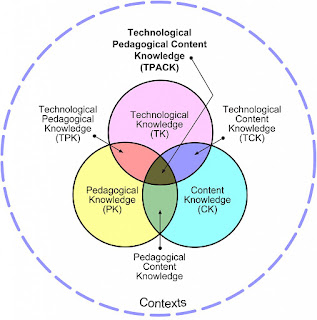TPACKs insufficient transitional model

The currently popular TPACK model separates technology knowledge from pedagogy and content, viewing technology as a set of basic operational skills with a thing or things. This might be useful if it will be seen as the insufficient perspective that it provides. It is the equivalent to saying that writing is the basic operational skill with pencils, pens, books and paper, with skill in using and safely storing and organizing the data put on them, with skill in installing and removing books and articles and switching out procedures for different writing sequences and using the postal service. Yes, we needed to know those things to think with text for the last several centuries, and we need to know basic digital skills for the 21st century but this perspective loses sight of the forest for the trees.
TPACK is a transitional digital immigrant perspective forced on education by its low socio-economic status in our culture. Education’s SES has long prevented digital technologies from becoming ubiquitous for its primary constituents (educators and students) in contrast to the way that digital utilization has evolved in every other major industry of our culture. The TPACK model is akin to someone learning that new language, a learner focused on its underlying structure, not yet fluent, not dreaming in the new language yet.
To the digital natives steeped in the new tools, literacy has been transformed by the digital page. There are two overlapping circles, not three. Digital literacy is content. It is one of the major content areas; software (not hardware) is king; information is valued for its distribution not its possession; technology is the invisible infrastructure that makes it all happen but never the focus of the scene. The new literacy is the particular content that deals with expression and problem solving in the minute-to-minute digital happenings of their lives. These “expressive arts” are the new language arts. The words language, reading and writing are now but a subset of the larger means of expression, understanding and composing.
Digital literacy is so much more than the expression of words, having made significant progress towards having a means for editing, mixing, archiving and transmitting the full range of human senses and unique capacities. The software that holds the ideas for digital understanding and composing has major categories of many variations with a rich history of practice prior to and on the Web: text, still image, video, audio, 2D animation, 3D animation, sensors/robotics, and social interaction. I take literacy to be the capacity to compose and understand what goes on a page (or frame). Arguably within a decade these fundamental elements of digital literacy made most of the former literate world illiterate or functionally illiterate with these newer means of digital expression on screens and Web pages. This takes time for cultural digestion and transition.
This cultural transition should also be seen within a much larger scene. The current economic malaise that so impacts world educational progress can also be seen as a holding action, an impasse between the forces of information and those of wealth and force. Our setting is caused in part by our current culture’s deep misunderstanding of the unique economic and cultural power of information and its current dominating digital nature (over 94% digital), which contrasts to our long practiced history with the cultural powers of wealth and physical power/force (manufacturing, military, agriculture) (Toffler, 1990). The political process of putting the digital natives in positions of significant leadership and authority is going to take some time.

Comments